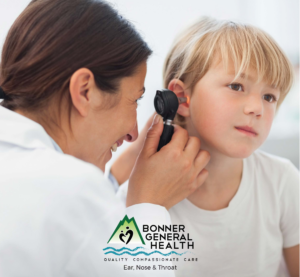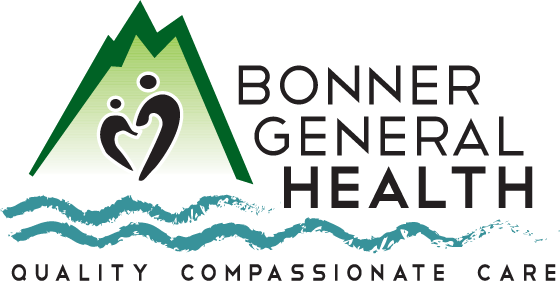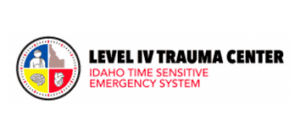
From Infants to Teens, tips for keeping your kids’ ears, nose, and throat healthy at every age.
By: Dr. Susan Anderson, Otolaryngologist – Bonner General Health
February is Kids ENT Health month. Ear, nose, and throat ailments are a prime reason children need health care. Primary care providers and Pediatricians manage the majority of these complaints. Common conditions that bring a child to an Otolaryngologist (an Ear, Nose, and Throat Specialist) are recurring ear infections, concern for hearing loss/speech delay, nasal congestion, nose bleeds, and tonsil related issues.
Ear infections are the most common ailment in childhood; 80-90% of children will have an ear infection by three years of age, with the highest incidence being between 6 and 18 months. Ear infections are also the most common cause of antibiotic use in children in the United States. Fortunately, most ear infections resolve with treatment, and children typically outgrow ear infections by ages 3 to 5 years. A consultation with an Otolaryngologist for children who have four ear infections within six months or six within 12 months is recommended. If the fluid in the small space behind the eardrum (the middle ear) does not resolve within three months of an ear infection, a specialist’s referral is warranted. These children will frequently need ear tubes to help the middle ear fluid drain, thus preventing the build-up of liquid and bacteria in the middle ear. [1]
Tonsil and adenoid issues are common for consultation in the Ear, Nose, and Throat Clinic. The tonsils are located in the back of the mouth on each side. The adenoid is in the back of the nose. The tonsils are visible by looking in the mouth, but the adenoids typically cannot be seen on routine exams. Evaluating the adenoid usually requires passing an endoscope through the nose or obtaining an x-ray. The tonsils and adenoids are lymphoid tissue and part of the immune system, but their role is limited. Removing them does not weaken the immune system, and for some, removal may reduce the frequency of illnesses. A provider may consider removing the tonsils or adenoids if they are excessively enlarged or frequently infected. Tonsils and adenoids do not need to be infected to become enlarged. Children often have obstructive problems from enlarged tonsils and adenoids without ever having had sore throats or “strep throat.”
Problems sometimes caused by enlarged tonsils and adenoids are; obstructed breathing during sleep (i.e., sleep apnea), poor disposition and irritable behavior, eating problems, constant nasal obstruction, and congestion or poor alignment of teeth, and abnormal facial development. Parents may seek consultation regarding tonsils after noticing loud snoring and restless sleep.
A newer ailment seen in the ENT Clinic is hearing loss in teens and adolescents associated with earbuds or headphones. Kids listen to electronic media at levels that are often louder than what is allowed by law in a workplace, leading to high-frequency hearing loss. However, it is not just the volume causing the hearing changes, but the amount of time using earbuds/headphones. Children today spend more time listening to electronic media; hearing damage is similar to sun damage; it is additive over time, and too much causes harm.
One study showed 14.2% of school-aged children have high-frequency hearing loss or other audiometric changes [2]. To protect your child’s hearing, kids should take breaks after an hour of listening and turn the volume down to about 60% on their audio players.[3] The best practice for everyone is, you should be able to hear conversations going on around you while listening to your media with earbuds/headphones. Also, kids should not sleep with their earbuds/headphones on; this is additional “trauma time” to their hearing.
For more information or to reach Dr. Anderson, call Bonner General Ear, Nose, and Throat Clinic at (208) 265-1003 or visit www.bonnergeneral.org.
- Rosenfeld, RM, et al. Clinical Practice Guideline: Tympanostomy Tubes in Children. Otolaryngology-Head and Neck Surgery149(1S) S1–S35 American Academy of Otolaryngology-Head and Neck Surgery, Foundation 2013 2. le Clercq, CMP, et al. Association Between Portable Music Player Use and Hearing Loss Among Children of School Age in the Netherlands. JAMA Otolaryngol Head Neck Surg. 2018;144(8):668-675. 2017 American Academy of Pediatrics
Article submission for publication in Sandpoint Living Local Magazine – February 2021.









